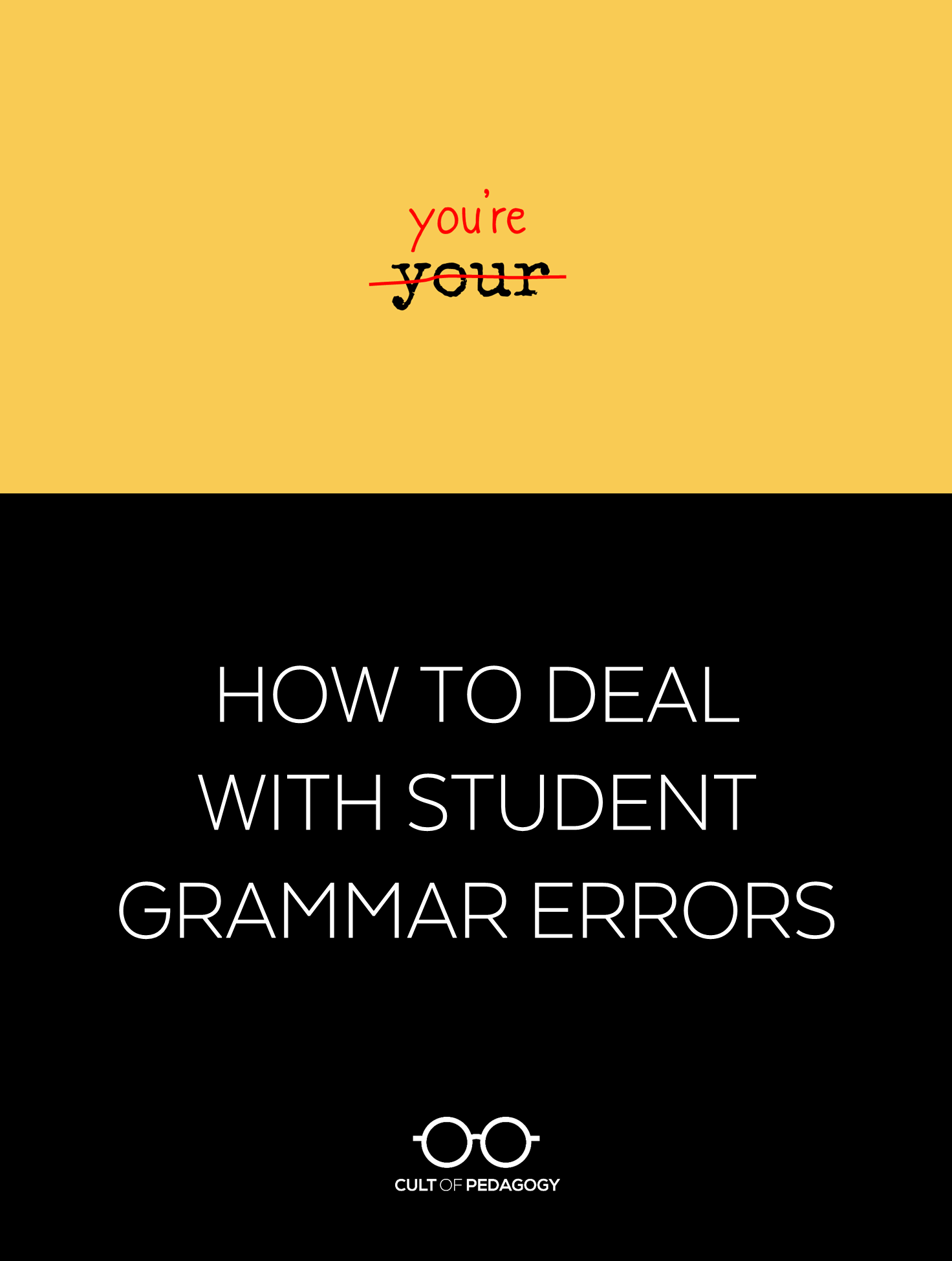
Listen to this post as a podcast:
Sponsored by Write About
It happens at the start of every school year: Teachers decide that once and for all, they are going to fix the problem of student grammar errors. These kids can’t write, they say. They don’t know their parts of speech. They can’t spell. They write in “text language.” Their writing is full of run-on sentences. They don’t even put capital letters at the beginning of sentences anymore!
I mean, what did they teach them last year, anyway?
And so it is decided. Before getting into any curriculum this year, before having students write a single thing, they are going to get back to basics: One, two, three full weeks of nothing but parts of speech lessons, grammar drills, punctuation exercises. Surely if they teach it hard enough, that ought to take care of it.
Except it doesn’t.
As the school year wears on, despite all those drills, students continue to make the same mistakes. And all across the land, their teachers’ voices rise in chorus: “I taught you this! We went over this! Don’t you remember?”
Teaching Grammar Out of Context Doesn’t Work
First of all, let me quickly mention that when I say “grammar,” I am broadly referring to all the conventions that make writing correct: spelling, punctuation, usage, capitalization, and so on. Rather than list all of those every time, I’ll use the term “grammar” to save time.
Okay, with that out of the way, here’s the most important thing any teacher of English language arts should take away from this post: Grammar taught in isolation, outside the context of meaningful writing, has been found to have no significant impact on the quality of student writing; in fact, excessive drills can have a detrimental impact on it.
These findings have been supported by decades of research.
In his exhaustive 1984 meta-analysis of over 500 published studies on composition, Hillocks found grammar instruction to be so ineffective that his summary sounded more like an admonition: “School boards, administrators, and teachers who impose the systematic study of traditional school grammar on their students over lengthy periods of time in the name of teaching writing do them a gross disservice that should not be tolerated by anyone concerned with the effective teaching of good writing. Teachers concerned with teaching standard usage and typographical conventions should teach them in the context of real writing problems.”
These findings were corroborated three decades later. In a 2012 meta-analysis of 115 studies or other publications, researchers looked at the impact of six different writing interventions that involved “explicitly teaching writing processes, skills, or knowledge.” The only one of the six that had no statistically significant effect was grammar instruction, and half of those studied actually produced negative results (Graham, McKeown, Kiuhara, & Harris, 2012).
In fact, the evidence is so strong against this kind of teaching that the National Council of Teachers of English put forth a resolution affirming that “the use of isolated grammar and usage exercises…is a deterrent to the improvements of students’ speaking and writing.”
Even without academic research to back it up, the ineffectiveness of piling on grammar drills is evident every time a teacher implements the practice, only to discover that it hasn’t had any significant impact on the quality of student writing.
In her 2014 piece for The Atlantic, “The Wrong Way to Teach Grammar,” Michelle Navarre Cleary describes her own experiences teaching in an urban community college, where most students failed to complete a two-year degree in three years. “These students are victims of the mistaken belief that grammar lessons must come before writing, rather than grammar being something that is best learned through writing. A primary culprit: the required developmental writing classes that focused on traditional grammar instruction. Again and again, I witnessed aspiration gave way to discouragement. In this seven-college system, some 80 percent of the students test into such classes where they can spend up to a year before being asked to write more than a paragraph. Nationally, over half of university and college students in developmental classes drop out before going any further. Essentially, they leave before having begun college.”
A More Effective Way to Teach Grammar
So what should teachers do instead?
1. Give Students LOTS of time to read and write.
There is no better way to improve students’ writing than to have them read and write as much as possible. Building your daily classes around some form of Reading Workshop and Writing Workshop is a good place to start.
By the way, “reading” means real books, articles, and other texts that will turn students into people who love to read and read frequently. Regular exposure to lots and lots of good writing will naturally improve the correctness of students’ writing. This is much less likely to happen with scripted reading programs or day after day of reading passages that have no meaningful context. Read Donalyn Miller’s The Book Whisperer for inspiration on how to make this happen.
“Writing” means both formal pieces that are taken all the way through the writing process and informal writing, like journal entries and free-writes. If you choose to abandon most or all of your formal grammar instruction, you’ll free up lots of class time for students to do this.
2. Curate a database of quick grammar lessons.
All the reading and writing in the world won’t magically turn students into perfect writers. Because they will continue to make mechanical errors, and because these conventions are best taught within the context of the writing they’ll be doing in your class, set up a system that allows individual students to quickly learn the conventions they need: This could take the form of a file cabinet or even a shared drive with folders that contain one high-quality lesson for each error: a folder for your-you’re errors, a file for then-than errors, and so on.
These lessons can come from almost anywhere—an old textbook, YouTube videos, worksheets you’ve collected over time, or a combination of these. What’s important is that they are (a) effective: Rather than dumping everything you can find into this folder—which will only frustrate and confuse students—curate only the most effective materials, and (b) self-running: Set these up so that students can access and learn from them independently, without requiring your help.
3. Have individual students do individual lessons as needed.
Now, as students do the daily work of writing in a range of genres, for a variety of purposes—which you have just made lots of extra time for by cutting whole-class grammar instruction out of your plans—send individual students to these lessons as needed. Students can go to the lesson they need, refresh themselves on the rule, and then get back to their writing, where they can correct the error and keep an eye out for future uses of that same convention.
Occasionally, you might find that many students are making the same error, in which case it may be appropriate to spend five minutes reviewing a concept as a whole class. At other times, you might want to push students to try more advanced types of sentence structures; so doing craft lessons like a study of mentor sentences could be an effective way to accomplish that.
Eventually, once students become familiar with your database of lessons, they should start to seek them out on their own as they write. This is the ideal: Students who are aware of when they need help, and who can find the resources they need to help themselves.
4. Understand that this is a process.
You will never, ever be able to teach in such a way that all students are error-free, and even students who understand the rules will occasionally mess up. Spend 10 minutes on social media and you’ll see that most adults are still constantly making grammar errors. So rather than try to fix it once and for all, get your students reading and writing as much as possible and help them develop a personalized, proactive approach to producing correct writing.
Want a Fantastic Collection of Short Grammar Lessons Ready to Use?
Grammar Gap Fillers are designed to fit perfectly into a writing workshop environment, where students access only the lessons they need, when they need them. Each Gap Filler contains a short video, a Self-Check quiz the student takes on their own, and a handy Cheat Sheet they can keep in their notebook to remind them of the rule.

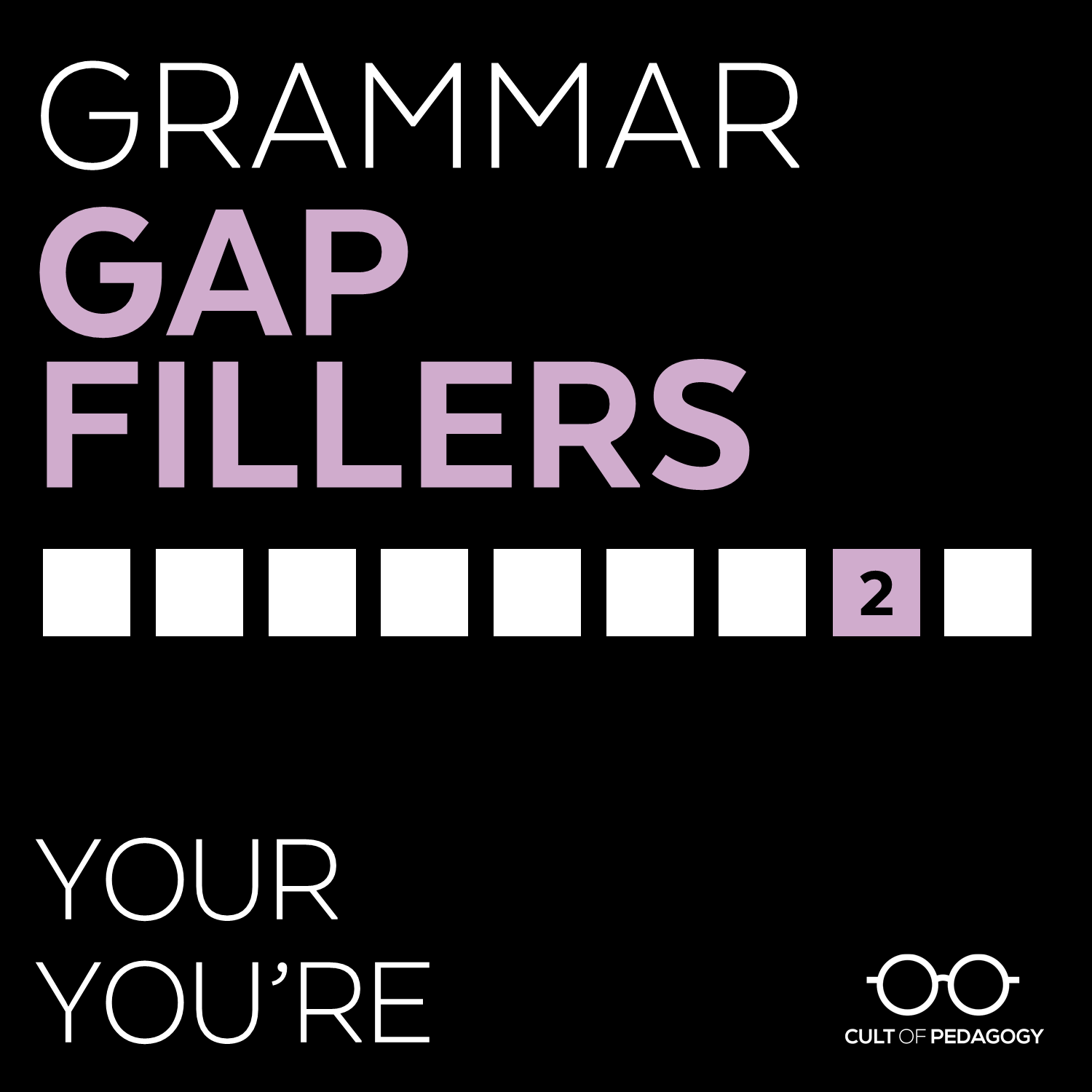
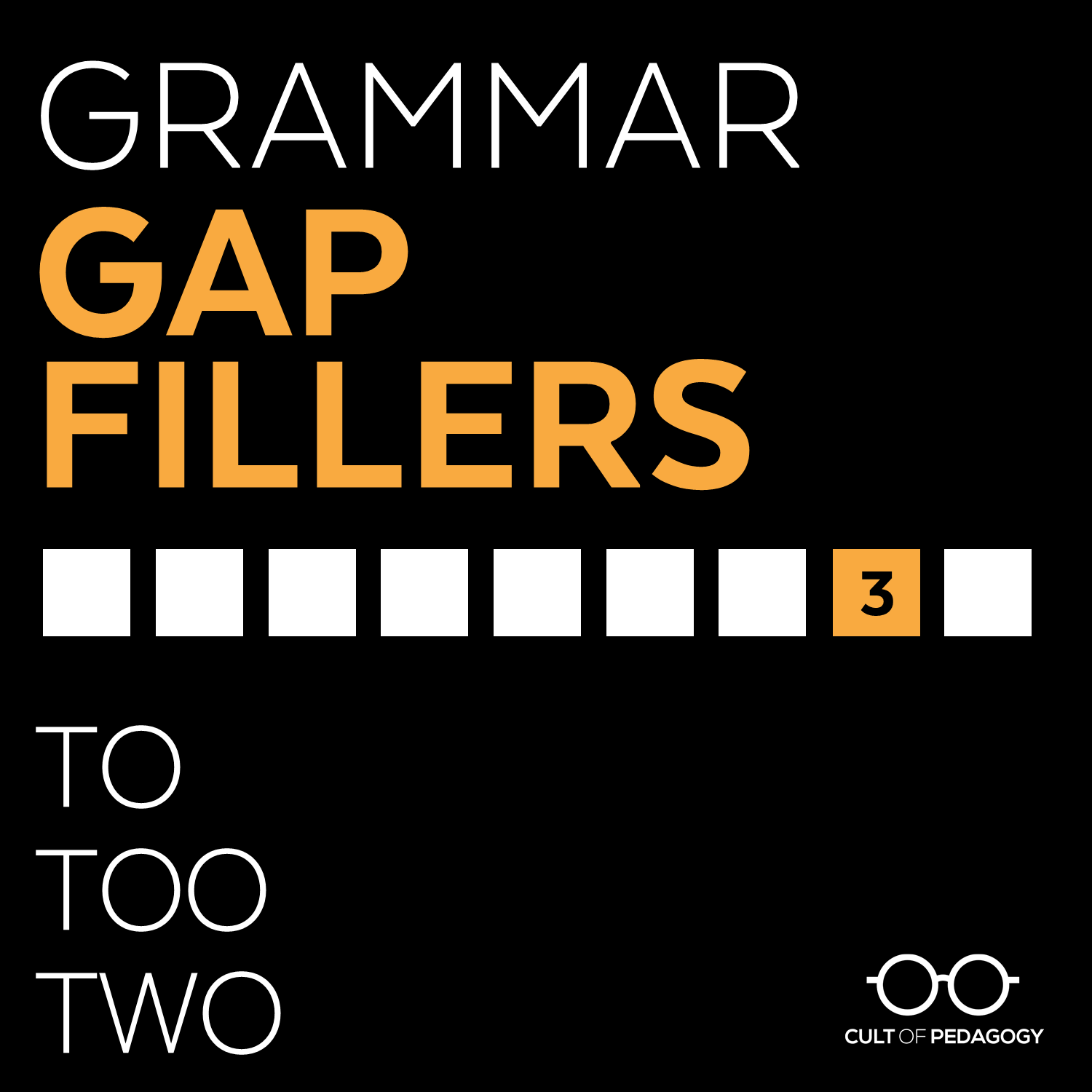
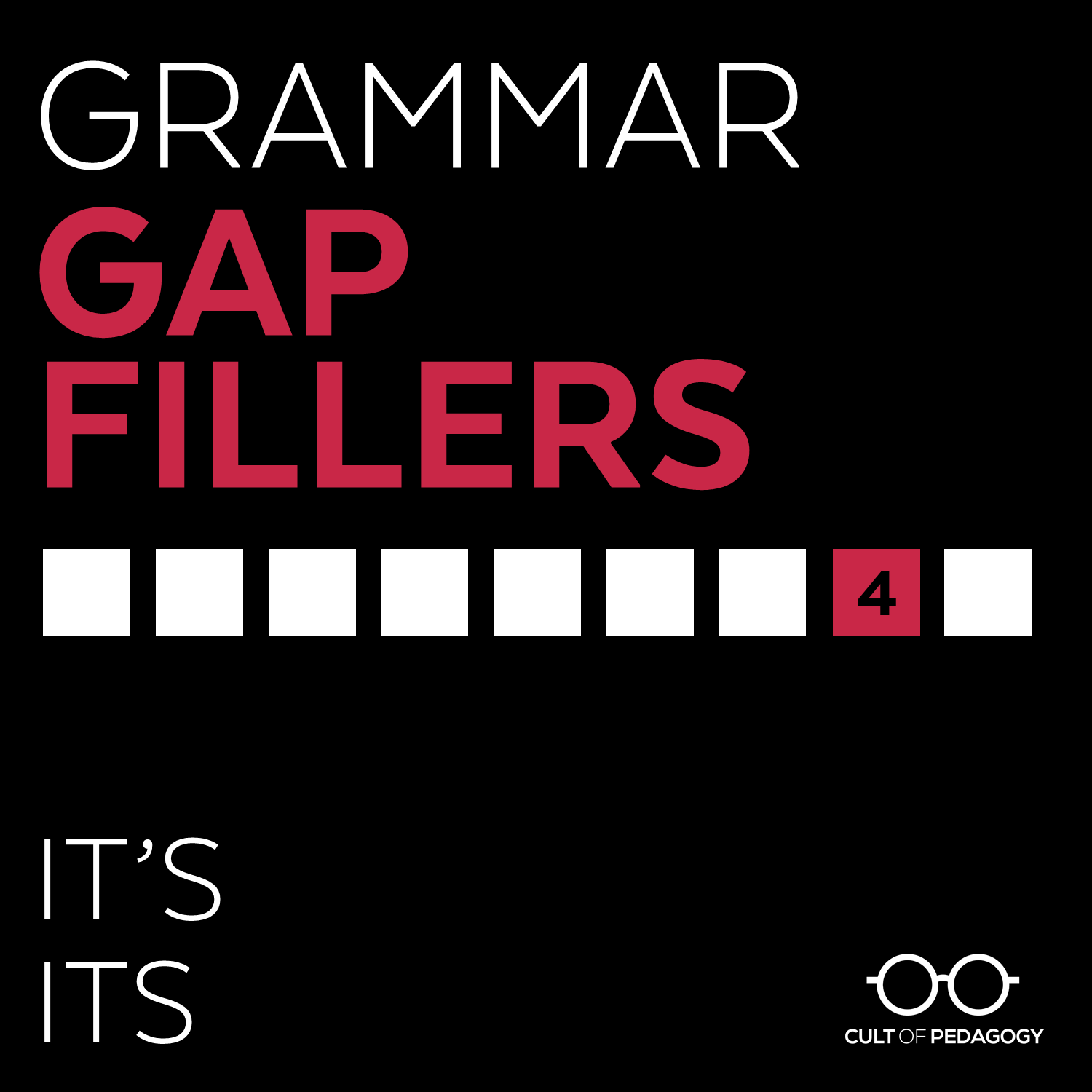
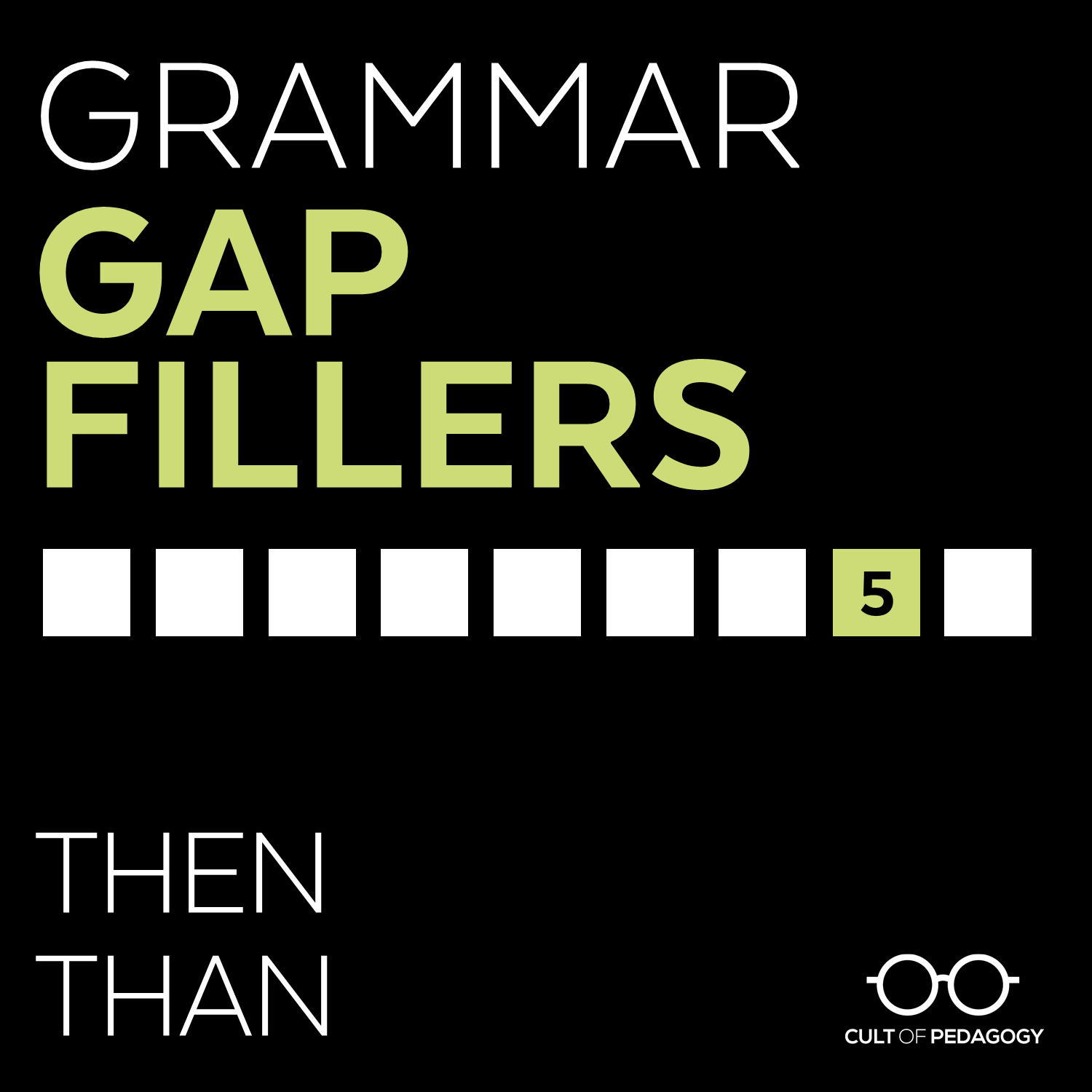

References
Cleary, M.N. (2014, February 25). The wrong way to teach grammar. The Atlantic. Retrieved from theatlantic.com/education/archive/2014/02/the-wrong-way-to-teach-grammar/284014/
Graham, S., McKeown, D., Kiuhara, S., & Harris, K. R. (2012). A meta-analysis of writing instruction for students in the elementary grades. Journal of Educational Psychology, 104(4), 879-896.
Hillocks Jr, G. (1984). What works in teaching composition: A meta-analysis of experimental treatment studies. American Journal of Education, 93(1), 133-170.
National Council of Teachers of English. (1985). Resolution on grammar exercises to teach speaking and writing. Retrieved from ncte.org/positions/statements/grammarexercises
Join our mailing list and get weekly tips, tools, and inspiration that will make your teaching more effective and fun. You’ll get access to our members-only library of free downloads, including 20 Ways to Cut Your Grading Time in Half, the e-booklet that has helped thousands of teachers save time on grading. Over 50,000 teachers have already joined—come on in.


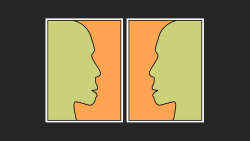


Good information. Seems like basic math facts should be approached the same way. I’ve seen teachers spend weeks reviewing basic skills, but by the time the student needs to apply the skill, they have already forgotten their basic facts again.
Grammar is learned through meaningful reading and writing.
I think I need more understanding of grammar so that I can give the support that all students deserve who are in EL.
I love this post and these resources! Perfect for individualized lessons and for giving students control over their learning! Thank you!!!
I am in the process of revamping a Comm Arts class into a Grammar/Writing class. Just teaching grammar itself during the past two years has been a little piece of hell on earth! I knew I needed to teach grammar in the context of writing, and that is what my goal is for this year. Jennifer, what is your opinion of such grammar-type programs as IXL for Language Arts? I have used it to a great extent for grammar practice. Is something like IXL as effective a tool as we are told it has potential to be? I’m not so sure anymore after doing my own research on teaching grammar and in reading your blog post. What do you think? Thanks for this post and for the resources that will assist with my planning and, with great hope, teach my students to be better writers. Now, I need to get to work on this…
Hey Doreen!
At first glance, it seemed as if IXL only offered practice exercises, but no actual lessons on any of the concepts. After I deliberately got some questions wrong, I realized they do corrective re-teaching only after the student gets an answer wrong. I’m not crazy about this approach, because students have to sort of fall into the instruction, rather than being able to proactively access it.
A program like No Red Ink has a similar objective–to teach these kind of targeted lessons and measure student understanding–but they at least offer the lesson up front. As a teacher and a student, I would prefer this. Of course, the lesson is simply delivered in written form, kind of like reading a PDF or a piece of paper that explains the rule, so some students may still not get it (which is why I created videos for mine), but I could definitely see a platform like this providing good on-demand lessons when students need them. What I wouldn’t do is force all of my students to go through all of the lessons one by one. Mind-numbing torture!
I’m curious about the impetus for the revamping of your course. What was it originally (in other words, what was covered in the Comm Arts class?) and what are the goals for the new course? You’re calling it Grammar/Writing, but I’m wondering which of those two gets more emphasis. Is the revamping your idea or did it come from above you? Just wondering how these decisions are made.
I would also look into the work of Kelly Gallagher and Penny Kittle. Everything I have heard from both of them tells me they are right in line with what works best in writing instruction.
Stay in touch and let me know how it goes!
Hi Jennifer, thanks for this excellent post. It confirms my very strong gut feeling about the teaching of grammar, based on 35 years of teaching English in the public system (in Australia). I look forward the reading the information in your links. In the school I teach at we deliver two packages : the Be A Super Speller system, based on morphographs (from the US, I believe), and one called Grammar Matters. The morphograph spelling system is a good one, particularly for students who haven’t done enough reading to notice/pick up English spelling rules…..which is most of our cohort. However I agree that these understandings just don’t ‘stick’ unless there’s a lot of follow up and practise.
I’m less convinced about the value of the Grammar Matters programme…..sometimes I feel like I’m actually messing with the kids’ heads by banging on about adjectival clauses!! Recently both of my Year 7 classes have been writing narratives, and I have been able to work one on one with most of them at several points during the process. (Only possible because these kids are mostly well behaved and are LETTING me do this!) My absolute bug-bear is the run-on sentence, and I usually focus on that, and perhaps punctuation of direct speech, ignoring spelling at that particular moment. I really enjoy asking students to read a sentence to me, listening for the ‘pause’ or the ‘breath’ that means the sentence should have ended. They have much more chance of understanding what a sentence is in doing this, and feel as if they own their own revising.
I’ve also had success by typing up student errors ( focusing one one aspect only, such as run-on sentences), projecting these sentences on the board/screen, and the students correct one of these errors per day in their workbooks, or directly on the whiteboard, with the Pen of Power. We call it Conquering the Run-On sentence…one day at a time. Obviously I don’t ever put student names on the work projected.
I’m pretty sure that very few kids I’ve ever taught could tell you, as an adult, what a dangling participle is…..but they appear to be living fufilling and useful lives without it!
Best wishes to all you northern hemisphere teachers for a wonderul break. Think of us down under recovering from the pain of Naplan (national testing), and heading into winter.
Tracet V
Thanks so much for sharing your insight, Tracey!
For a lot of years now, I have been using the Canadian Spelling Program textbook in my classroom. I have also given the Morrison McCall spelling test at the beginning of September and the end of June. When I use this program, my students consistently demonstrate growth in their spelling skills as a whole group (not every single student, but as a whole). Moreover, in years when I have not used this textbook, or used another program instead, growth in spelling skills is quite flat across the class from September to June. Perhaps a well rounded program (which I think this is) is what matters. In addition, the students learn other skills such as following written directions independently and organizing their work. This is not a large part of my language program, but I do think it fills a valuable gap.
Hetty, I’m glad you brought this up.
My understanding is that the research strictly on spelling is a bit different from what I more broadly refer to here as “grammar.” I did a Periscope broadcast in 2016 about this in response to a reader question (fast forward to about 6:35…let’s just say I was new to live broadcasting). What I found is summarized in this document. To sum it up, the research suggests that direct instruction in spelling does have a positive impact on students’ spelling skills, especially if the program is well-designed, if students are given lists that match their readiness, and if students are taught self-correction strategies. The results you’ve seen sound consistent with this research.
The authors of one study did make a point of noting that spelling instruction did NOT impact students’ overall writing skill, which makes sense. But it sounds like your point was specifically about spelling. Also, it sounds like you are employing a lot of other strategies in your class, so if the spelling portion is only part of that larger whole, and it’s working the way you described, I’d say keep doing what you’re doing!
Thanks for writing this post. I agree the debate has been going on for 100’s of years. One other item I would like to add to your list is to respect the spaces that students write in on a daily basis. Trying to tell students that they shouldn’t write a certain way will only compound the problem. Today, I fee students need to learn how to code switch and learn when it is okay to write formally and informally. Please check out the book Troy Hicks and I wrote that was jus released in May, From Texting to Teaching. We cover the history of grammar there too. Again, thanks for the post.
Hi, Jeremy–this is Holly Burcham, a Customer Experience Manager. Thanks for letting us know about your book! We’ll check it out soon.
Ms. Gonzalez,
Great podcast, but I’m left with a question.
It makes sense that general reading trumps rote exercises for improving grammar. Where does Quizlet, a site you recommend in your tech course (which is amazing), fit into this discussion?
Are the Quizlet activities (flash cards, etc) susceptible to the same criticisms raised against stand-alone grammar drills?
I teach in a Native Alaskan village, and my dual-language students struggle with English vocabulary. They enjoy Quizlet, which we used in most every class last year.
Their MAP scores improved, and until I listened to this podcast I attributed some of that success to the regular use of Quizlet.
Any thoughts on this issue?
Thank you,
Steve Jennette
Hi Steve! So sorry for the late reply; we were going through old comments and saw that this one was never answered! It sounds like you are using Quizlet flashcards for vocabulary development. I see that as a completely different thing from grammar, and actually, I’m a big fan of flashcards in general. (See my more recent post on retrieval practice). I’d say keep doing that!!
Jennifer, this is great information. I sincerely hope that only a few still approach teaching grammar in isolation from writing itself! I was hoping you might also say something about the use of Grammarly which is a fantastic free Chrome extension tool for correcting all types of grammar errors! Such technology is changing what we need to teach, not don’t. I imagine a day when we really do not need to spend much time teaching the “mechanics” of writing but focusing our valuable and limited time almost exclusively on developing the unique aspects of writing: voice, diction, sentence structure, point of view, content, etc.
Also, you may want to try to keep your podcasts (of this sort) under 15 minutes.
This podcast and the info you share aligns pretty much with what TPRS and CI teachers are doing in modern foreign languages. You don’t happen to have a version of the Grammar Gap Fillers for Spanish do you? Or do you know anyone who does? I like this idea!
Hi, An! I’m a Customer Experience Manager with Cult of Pedagogy. It’s great to hear you like the Grammar Gap Fillers! We’re so sorry, but we only have these available in English; Jenn just isn’t proficient enough to do them in Spanish. Thanks for asking about this.
We use a workshop model at our school, so your grammar gap fillers should work well for us. I have a group of students this year who are particularly lacking in the fundamentals of writing and grammar, and they are apathetic about improving their skills. What is your approach to assessment and accountability of learning and using these skills in practical writing assignments? Ideally, students would be instructed to watch the tutorial videos, self-check, etc. as you suggest, and then they would begin applying this knowledge in their own writing. What about students who don’t care if their writing improves? How do I police, so to speak, the students who aren’t motivated to watch the videos and practice on their own? Do you suggest assessing these skills individually somehow?
Hi, Danielle! This is Holly Burcham, a Customer Experience Manager. My co-CEM Debbie was able to spend some time with your questions, and I’m here to pass along her answer!
You’re already using the writer’s workshop model which is a great place to start. I’d stick with teaching and assessing the skills through writing. If you haven’t already, check out Delaying the Grade: How to Get Students to Read Feedback as well as Know Your Terms: Holistic, Analytic, and Single-Point Rubrics.
Also keep in mind that some kids may not be ready to go off and work independently on a Gap Filler or some other intervention. It may be best to work with them during 1:1 conferences or small strategy groups, providing direct instruction, modeling, and guided practice.
The other thing to consider is the motivation piece. You may want to check out 5 Questions to Ask Yourself About Your Unmotivated Students to see if it is relevant in any way.
We hope this helps!
I love your perspective and attitude regarding teaching. However, I notice that the exercises provided are focused on word choice only. How do you recommend addressing the skills needed to properly use commas, apostrophes, quotation marks, etc.? Is there a program or resource out there that has been proven effective when focusing on these more mundane, mechanical skills?
Hey, Kristin! This is Holly–I work for Cult of Pedagogy. Have you tried NoRedInk yet? That’s where I would start. Other than that, we don’t really have any products to recommend. However, this spring Jenn plans to release a 2nd set of Grammar Gap Fillers videos which will be more focused on more than word choice errors. Hope this helps!
Hi Jennifer, Holly, and Kristin! I know it’s been almost a year since this discussion but I need to recommend the fantastic work of Jeff Anderson. He just released a new book which is fantastic but I think what you may be looking for are the ideas in his older book Everyday Editing (also fantastic!)
This post was recently shared on Twitter, and I’m glad I got the chance to read it! I’m wondering your opinion on using brief bellringers as it relates to grammar? My school was putting pressure on preparing for the ACT test last year, so we did a 3 week grammar unit right before the test and we hated it. We knew it wasn’t effective when it wasn’t in context. This year to take a step in the right direction we are nixing the unit and instead doing grammar bellringers twice a week…
My experience is in elementary, but I’m thinking if you’re seeing kids are engaged and the practice they’re getting from the bellringer activities is transferring into daily school work, then it seems like they’d work well as a kind of retrieval practice. However, if kids are doing well on the bellringers, but continuing to make the same errors in their work, I’d re-evaluate how you can use them more effectively.
I work with 2nd, 3rd and 4th graders at an International school in HaNoi Vietnam. I sought ways to help students with errors in grammar because I’m taking a linguistics course that is focusing on ‘interlanguage rules” this week. Your podcast fits in perfectly! Thank you!
So great to hear this — thanks for letting us know, Jeni!
The Reading and Writing Workshop link is no longer functioning. Is there an alternate link? Thank you:j
Yikes! Thanks so much for letting us know about this, Jennifer. I did a quick search and I think this article gives a pretty good overview of the Reading and Writing Workshop model. If you haven’t already, I’d also check out How to Stop Killing the Love of Reading — these practices align nicely with the Reading Workshop model. Hope this helps!
I also view this issue as an attention to detail within the discipline of writing. By this I mean, when reviewing a piece of writing, students can often make edits immediately when focused on a specific paragraph or if necessary a specific sentence. Most often in my experience, they are more successful as peer editors than self-editors. Emphasizing the reading and writing connection can be a pro-active approach. Instructing students to practice how to review their writing through the lens of a reader is most beneficial. The need for attention to detail can be recognized at many levels.
I didn’t see any mention of dyslexia (I include dysgraphia in that term) in the article. Many dyslexic individuals become writers, but the traditional methods of teaching don’t help this population such as more exposure to reading and writing. Dyslexic people need different instruction, but more importantly, support and encouragement with their unique way of thinking (creativity is often a strength). I think with more emphasis being placed on dyslexia recently, we will be able to better support these students in the near future and decrease teacher burnout and frustration. I know teachers want to be effective, it’s worth it to look into this topic for the students and the teachers. Thank you for all you do!
The research information on this site is (at best) incomplete. The problem is not the method (e.g., grammar in isolation or in context or drilling vs. whatever). The problem is the transfer of knowledge from one domain or mode of learning to usage in another. The magic won’t come from what I read on this blog.
Hi Elsa,
Good point – transfer and application of knowledge is always the goal of any lesson. The strategies presented in the article are intended to help make that transfer happen. If you have a moment, it would be great if you could share any other research you’re aware of that could support teachers as they work with students who are struggling with transferring grammar skills into their writing. Thanks so much!
Wow. What an amazingly timed post! I just spent a week of grading finals for my drama classes and my Academic Language Skills (long-term English Learners) classes. Because I, apparently, like to punish myself, all four classes had essays for finals. I was more forgiving with my drama classes, as it is not an English class, but used the same grading standards I’ve been using all year for writing in my ALS class. Each rubric only have 5 points allotted for spelling/grammar/word choice, so no kid could lose more than 5 points. Of the 53 tests I graded, I literally only gave a total of 3 points in this category, and they were all for the same kid. I am absolutely loving the approach and resources listing here. This will become more important, as a transition to 3 sections of 9th grade English next year. THANKS.
Thank you for this! The Reading and Writing Workshop link doesn’t work, so if you have the link, that would be great!
Dawn,
Thanks for bringing this to our attention. We will get this fixed! In the meantime, it looks like the link has been replaced on the website with two separate links:
Reading Workshop
Writing Workshop
I hope this helps!
Some good observations about the ineffectiveness of teaching grammar.
One thing that I have observed that focusing on what students can or cannot do in speaking and working on that is FAR more effective than working on writing first.
Once a student is able to speak it naturally than the mastering of same in writing will be relatively straightforward (ignoring writing conventions) . The other way is not…ie mastering the writing first.
Focusing on writing first accentuates language as knowledge. A no no. Whilst working on speaking first suggest to us to regard it as a skill… Which language is unless you are a linguist.
Teaching of speaking is what very few do well, and hence teachers tend to focus on writing. Seemingly easier but creating its own negative dynamic in terms of speaking.
Correction of grammar in speaking is all about having crystal clear situations (talking about lower levels here) which requires a certain language form. Then stopping students as they speak and make mistakes to see if they can self correct. If they can, then they know that they need to pay more attention to what they say. And the teacher knows that further teaching is not needed.
If they can’t self correct, then you and they know, there is something missing in their awareness and understanding.
Clearly the dynamics of how all that is done is critical. I use Humor interlaced with high focus to maintain a light and easy feel to the class – amidst serious intent.
If that makes sense! 😜🤓😊
Thank you for your post on dealing with student grammar errors. While I had tried to teach it as they wrote, I also did not notice improvement. I finally took a 3 week break to do a “grammar blitz”. Now, my conferencing with students is so much more effective because they now know what I’m talking about when we discuss how to become better writers in terms of grammar. We have developed a common language.
Hi Jennifer. This is really useful information so thanks for the repost. Here’s my question. Where can I find more resources like the ones you supply at the end of the post? I teach college. Some courses have traditional college age students and some non-traditional. Well some of my students are good writers, many have atrocious grammatical and punctuation errors. Including the teachers who are coming back for masters degree! The good news is I tend to see the same errors repeatedly. Aside from style ( APA Chicago), I see a lot of subject verb agreement, and using a comma after a dependent clause! I love the idea of having lessons for particular students to do to improve their specific weak points. But as a film studies professor at a university, composition is not my bailiwick. I have no idea where to look for quality resources. Any assistance you could give on this front would be greatly appreciated..
Hey Andrea, thanks for your comment! Jenn has many more instructional resources to help you with your classes on Cult of Pedagogy’s Teachers Pay Teachers site. You also might want to check out her post, 5 Ways College Teachers Can Improve Their Instruction. Another place to look would be her Pinterest board on Teaching English Language Arts. My background is in language teaching, and I’ve always found Betty Azar’s grammar website to be a good resource for teaching grammar. I hope this helps!
I would love some references on this for my Spanish students – I am really looking to make some changes this year and this sounds great – just looking for some help in getting started in the right direction.
Hey Rachel, are you looking for English grammar resources for Spanish-speakers studying English, or are you looking for Spanish grammar resources for English-speakers studying Spanish?
Hi Jennifer – As usual, excellent episode. I wanted to mention something I do to improve the “little things” in student writing (I teach at the high school level): While grading a set of students’ essays, I keep open a separate document, and when I come across examples of a pattern of grammatical errors, I copy/paste them anonymously into that document. Then, as part of the process of developing the NEXT essay, I present this document to them with their own sentence errors, grouped by the types of errors, and we work on how to fix or improve them.
I color code or underline or embolden the problematic portions of the sentences, and because the sentences are grouped by error-types, the class sees a collection of the same problem-area needing attention. In some cases, I write my own version of these sentences with improved grammar as a model (especially in cases of excessively wordy, unwieldy writing), and include explanations for the specific changes I made and why the sentence is better. In groups, then, they work together making better versions of the some of the sentences on the document.
The students are expected to demonstrate deliberate effort at improvements in these areas in the next piece of writing. In other words, fewer of these kinds of mistakes should occur. I’ve found this approach to be pretty successful.
Thanks again! You’re awesome!
– Dave
Hey Dave!
Love the feedback – I’ll make sure Jenn sees this. Also, appreciate you taking the time to share what you’re doing so that other teachers can benefit. Thanks so much!
Hi, Ms Gonzales. I was searching on how to teach students who keep forgetting spellings and grammar rules. I have this one student who misspells words occasionally. Like, in essay A she writes “affectif” instead of “effective”, then I tell her the correct spelling and she’ll spell it correctly the next time (say, in essay B). But when writing essay C she misspells it “affective”, then in essay D she spells it correctly, but in essay E she misspells it.
I suspect she has dyslexia or some sort cos it’s not only one or two words that she spells incorrectly. Say, in a 300-word essay, she could make >10 misspellings.
It’s very not common for me to meet students with problems like she has. In fact, she’s the first one, so it’s been frustrating.
Could you give me some advice on this? Thank you in advance!
Hey Nia, it’s no doubt that spelling continues to be a struggle for many students as they enter into the middle grades and beyond, and there are many reasons why this might be the case. One thing you’ll want to consider is the focus of your instruction. Writing an essay, for example, is a good place to first focus on crafting ideas and organizing thoughts. Focusing on grammar and spelling should come later as students go through the process of editing their work. If you notice students struggling with specific grammar or spelling points, it would be a good idea to bring that into a targeted mini-lesson where the grammar or spelling can be the main focus. The hope would be for students to then integrate that into their writing, which usually takes a lot of repeated practice. For some ideas on how to focus on spelling with older students in a more systematic way, check out this article.
Question: How are these Gap Fillers delivered or made available for each individual student to use? Can they be done at home on the student’s family computer?
Hello jennifer this post of yours has a great help in my research studies because most common problems in my students are like this. This really a very great advantage. Thank you
I’ve always known this strategy of teaching grammar in a more authentic way for student works, but incorporating it like you mentioned was what I was missing. I wanted to look into your Grammar Gap Fillers, but was unable to access a link anywhere. Could you redirect me, please? Thank you for all of your insights!
Hi Kimberlee,
So glad you found this helpful! To access the Grammar Gap Fillers, go to the post and scroll all the way down. Just click on any of the images; each one is hyperlinked to Jenn’s Teachers Pay Teachers store. Hope this helps!
Giving students more time to read and write vs drill and kill is something I have long felt was the way to go. When the light bulb goes off and a student starts to enjoy writing is a great moment.
I agree that providing a structure that allows students more time to read and write independently is very helpful in developing learners that are self-motivated and proactive.
Excellent information. It will help so much to educators, it will help me to be mindful of this strategies when teaching.
Hi Jennifer,
I love the grammar resources you have created. Do you have similar resources for punctuation?
Yup! All the Gap Fillers are over in Jenn’s TpT store. There’s a gap filler for sentence fragments, one for run-ons and comma splices and a few more that you might be interested in. Click here and take a look. If there’s something specific you’re needing that’s not there, let me know and I can pass it onto Jenn. Thanks!
Grammer is the number one thing I have been trying to work on. I am 67 and in my first year of college. Any programs you have I may make myself better, please advise me. I found your class full of information.
Hi, there. I LOVE cultofpedagogy! Every post is either a validation of what I’ve changed or (more often) an inspiration on what to change next. I’m interested in the gap fillers, but new brain research seems to suggest that teachers should not actually teach similar concepts together (ex.: they’re, their, there). Data shows better results with spacing similar content to allow students to get a firm grasp on one idea before introducing a similar one. Seems to me, the students who really need the gap fillers the most are the ones who would confuse the content the easiest. That said, I might be interested in the product if I could splice the video content on my end or maybe rework the worksheets to reflect single-idea content. This would be a lot of work, even for that all-in-one bundled price, though. What are your thoughts? Thanks!
Hi Amy, so glad to see you enjoying the Cult of Pedagogy content as well as engaging critically with the information presented. Your point about spacing the introduction of related concepts is valid. A previous post, Four Research-Based Strategies Every Teacher Should be Using,, talks specifically about spaced practice as well as retrieval practice and interleaving. While all are important, interleaving probably best fits the type of material offered by the Gap Fillers you referenced. As the article states, “With interleaving, mixing up very similar things provides that challenge where students have to know the difference, choose a strategy, and that then helps their learning.” So, Gap Fillers are designed to let students review just the skills they need, on their own, and then get back to writing.This means they can be used at any point, and if you have other materials for introducing the material, you can always use the Gap Fillers for review.
Just FYI, some products, like the Icebreakers, are editable, but the Gap Fillers aren’t. Ultimately, we recommend you use your professional judgement and do what you think is best for your students.